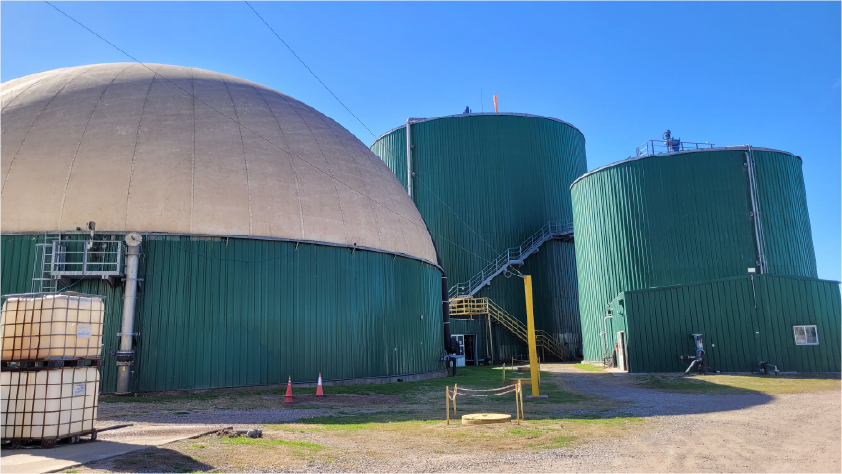Biogas is a renewable energy source with great potential for sustainability. It is generated through the bacterial decomposition of organic matter in an oxygen-free environment. Its main component is methane (CH₄), making it a clean and versatile fuel.

What is Biogas? Production, Uses, and Benefits
Biogas is a renewable energy source with great potential for sustainability. It is generated through the bacterial decomposition of organic matter in an oxygen-free environment. Its main component is methane (CH₄), making it a clean and versatile fuel.
In this article, you'll learn:
-
How biogas is produced
-
What raw materials are used
-
The main uses of biogas
-
Its environmental and social advantages
What is Biogas Made Of?
Biogas is not a single gas but a mixture of gases, primarily composed of methane (CH₄), which provides its combustible properties, and carbon dioxide (CO₂). This gas mix is the result of the anaerobic digestion of organic matter, carried out by microorganisms in oxygen-free environments.
Typical biogas composition:
|
Component |
Percentage (%) |
|
Methane (CH₄) |
50 – 70 |
|
Carbon dioxide (CO₂) |
30 – 50 |
|
Water vapor (H₂O) |
0 – 10 |
|
Hydrogen sulfide (H₂S) |
0 – 3 |
|
Other trace gases |
< 2 |
What Raw Materials Are Used?
Biogas can be produced from various types of biomass, making it a flexible and sustainable source of energy. Key feedstocks include:
|
Category |
Example Waste Streams |
|
Agricultural waste |
Manure, crop residues |
|
Agro-industrial residues |
Bagasse, fruit pulp, whey, organic effluents |
|
Urban organic waste |
Food scraps, kitchen waste, sewage |
|
Sludge from treatment plants |
Activated sludge |
|
Energy crops |
Silage maize, sorghum, grasses |
How is Biogas Produced?
The core process is anaerobic digestion, which takes place in a sealed, controlled digester without oxygen. The system maintains the optimal temperature for the activity of different groups of microorganisms across four main phases:
-
Hydrolysis – Macromolecules (fats, proteins, carbohydrates) break down into simpler compounds.
-
Acidogenesis – Formation of fatty acids and alcohols.
-
Acetogenesis – Conversion of these products into acetic acid.
-
Methanogenesis – Generation of methane and carbon dioxide.
Key Components in a Biogas System
-
Digester (Reactor)
-
Hermetically sealed tank where anaerobic digestion occurs
-
Made of steel, concrete, or other resistant materials
-
Designed to keep oxygen out
-
Feeding System
-
Introduces raw material into the digester
-
Can operate continuously or in batches
-
Mixing System
-
Keeps the substrate evenly mixed
-
Enhances contact between microbes and organic matter
-
Heating System
-
Maintains a stable internal temperature
-
Crucial for microbial activity
-
Digestate Extraction
-
Removes liquid and solid material after digestion
-
Gas Storage Tank
-
Stores biogas before its use or further treatment
-
Control and Monitoring Systems
-
Sensors for pH, temperature, gas volume, pressure, etc.
-
Ensure safe and efficient operations
What Can Biogas Be Used For?
|
Application |
Description |
|
Electricity generation |
Via combustion engines or microturbines |
|
Heating & cooking |
In adapted boilers or stoves |
|
Transportation |
As biomethane (after purification) |
|
Injection into gas grid |
As biomethane (after CO₂ removal) |
Environmental and Social Benefits
-
Reduction of greenhouse gas emissions
-
Reuse of environmental liabilities
-
Less contamination of soil and water
-
Decentralized renewable energy
-
Valorization of organic waste
-
Generation of local employment
Want to Use Biogas in Your Company?
At Bioeléctrica, we provide end-to-end renewable energy solutions by developing biogas projects that transform organic waste, agro-industrial effluents, and environmental liabilities into clean energy.
We support our clients at every stage — from planning to operations — with a focus on innovation and sustainability.
📩 Contact us: info@bioelectrica.com
